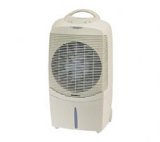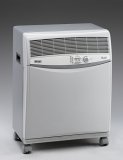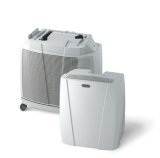
Domestic Air Conditioning Units
- A Simple Guide
by Jake KenJo
I know it may be hard to believe for some foreign visitors that may stumble upon this article but on occasion we in the UK have been known to swelter in the odd heat wave with temperatures as high as 35°c in places. It is during such a time when thoughts may inevitably turn to coveting thy neighbour’s air conditioning unit. So after many disturbed night’s sleep you decide enough is enough and make the decision to purchase your very own machine but what should you look for and where to start?
First things First - How they work A detailed explanation of the inner workings of an air conditioning unit is beyond the scope of this short article so here is a condensed overview of the bare essentials; An air conditioning unit and refrigerator work in a similar way. Imagine the inside of a refrigerator as your house or bedroom and you will get the idea. An air conditioning unit usually contains three core elements a compressor, a condenser and an evaporator. These elements may be packaged in several different ways depending on the type of unit purchased which may be an all in one portable unit, a two part split unit or centralised distributed unit. These machines all use a heat transfer or two phase fluid that can change from a gas to a liquid and vice versa. It is the properties of this special fluid that allow it to transfer the hot air from the inside of your home to the outside. Unfortunately this special fluid traditionally “Freon” or similar contains CFC’s which are said to have a negative effect on the ozone layer. The good news is that today new machines are being produced with eco friendly alternatives.
What types are available? The low end of the market in the UK is covered by equipment that is referred to by several names all meaning the same thing; Water cooler, chiller, and evaporative cooler - The latter name being the technically correct description. Actually this is a bit of a cheat as this device is not really an air conditioning unit at all. It works in a different way. A fan sucks air into the cooler where it is passed through a damp pad which is kept wet by water circulating through the machine. The theory is that the air picks up some of the water as it passes through the pad and its temperature drops. The cooled air is then blown back into the room. The benefit of this type of device is that running costs are said to be lower than conventional air conditioning units, unfortunately with domestic evaporative coolers the penalty for the lower running cost may be cooling capability.
Portable air conditioner - A stand alone singular unit probably the most popular domestic type in use in the UK today. These are available from all the major DIY outlets and catalogue stores. It consists of a machine on wheels with one or more long hoses which are used to direct the heat from the room to the outside world. In a warm summer the sight of open windows with hoses protruding from them in my area is both common place and to my mind somewhat odd. A 100 mm diameter hose merely stuck out of an open window cannot make for efficient room cooling but I guess it takes all sorts to make a world. Expect to pay around £170 for a 9000 BTU/hr unit and £250 for a 12000 BTU/hr unit of this type at the time of writing.
Split Unit - This type of unit is not portable and is generally used as a fixed installation for a single room. One advantage of this type of unit is that most of the noise is transferred outside of the house to the unit on the outside often referred to as the “cassette”. The whole cooling process is also said to be more efficient because the unit does not have to use it's own cooled air to reduce the temperature of the cooling coils. Expect to pay £400+ for a 14000 BTU/hr unit of this type (excluding fitting) at the time of writing.
Distributed Unit – Basically a fixed system that covers a number of rooms. Similar in nature to a split unit. The central system is housed in one place, for instance in a domestic house this can be in the loft. Ducting links the rooms to be air conditioned to the central unit which is vented to the outside. Expect to pay £2000+ for a 4 room unit of this type (excluding fitting) at the time of writing.
Things to look out for include; Energy Rating All electrical appliances supplied in the UK come with an energy rating. With air conditioning systems as with most electrical appliances a rating of “A” is the most efficient and therefore the cheapest to run. A “G” rating is currently the most inefficient and therefore the most costly to run.
Power Consumption Closely linked to the energy rating power consumption is usually expressed in watts. The higher the wattage the more it will cost you to run. Interestingly I note that a peculiar quirk of air conditioning units is that some manufacturers seem to still ignore the metric system and quote power consumption in BTU/hour. For comparative purposes it’s worth noting that 1 BTU/hour = 0.2928104 watts so a 10,000 BTU/hour machine would be 2928 watts.
Air Flow This is a measure of how much air flow the machine can put out and is usually quoted in metres cubed per hour written as (typically) 500m3/hr. Here the bigger the number the better.
Refrigerant This is a contentious issue for a growing number of people. The most common ozone depleting refrigerants sold under trade names such as “Freon” (Dupont) “Genetron” (Allied signals) and “Arcton” (ICI) are CFC012, R-502 and HCFC-22. If you are one of those concerned with the future of the planet then avoid the purchase of machines sold with those refrigerants. Fortunately today there are alternatives available and many machines are now sold with more environmentally friendly refrigerants such as R410A, R410B, RS-44 and others.
Recommended Room Size Self explanatory, this is the biggest room size the machine can cope with. The number specified assumes cooling the room from one (high) temperature down to another (lower) temperature. i.e. 32°c to 18°c or similar in a good year!
Noise Not something to overlook especially if you have the machine in the bedroom and expect to get some sleep at night. Noise is measured in decibels or dB for short. The decibel scale is logarithmic meaning the higher the number the noisier the machine. If you are a light sleeper either get some ear plugs or look for a machine with a low dB level. At the time of writing a noise level of 50dB is fairly typical for a portable air conditioning unit.
Programmable Definitely a desirable function for both temperature and time control. Dial in a temperature and the machine cools the house or room to the desired temperature at the time you specify. This is also a good cost saving aid. This feature is sometimes combined with a remote control unit.
Does it do anything else? Some machines are also able to act as a heater and humidifier which are useful functions that could extend the use of the machine throughout the year. This may be particularly important to you if you have humidity problems in the depths of winter.
Safety If you do decide to purchase an air conditioning system of any type please ensure it is correctly maintained. The water in the tank must not be allowed to stagnate. A badly maintained water tank can harbour Legionella if it is not emptied and cleaned regularly. This can cause problems for vulnerable people such as children, the elderly and those with weakened immune systems.
A final word If global warming is real then I guess sooner or later we will all be buying AC units in the UK. There is already a clear trend to increased annual sales of these units which mirrors what has happened in recent years with cars - even base models come with AC these days. I don’t know if that is a good thing or a bad thing. What I do know is in countries where high temperatures are the norm, AC units are regarded as essential as we regard home heating today.
A selection of domestic Air Conditioning units are available at Electric Shopping and Amazon.co.uk
Jake KenJo writes on Home and Garden Topics.
Prices and availablity are correct at time of writing: June 2007 Updated March 2013
Pressure Washers
Garden Shredders and Chippers


